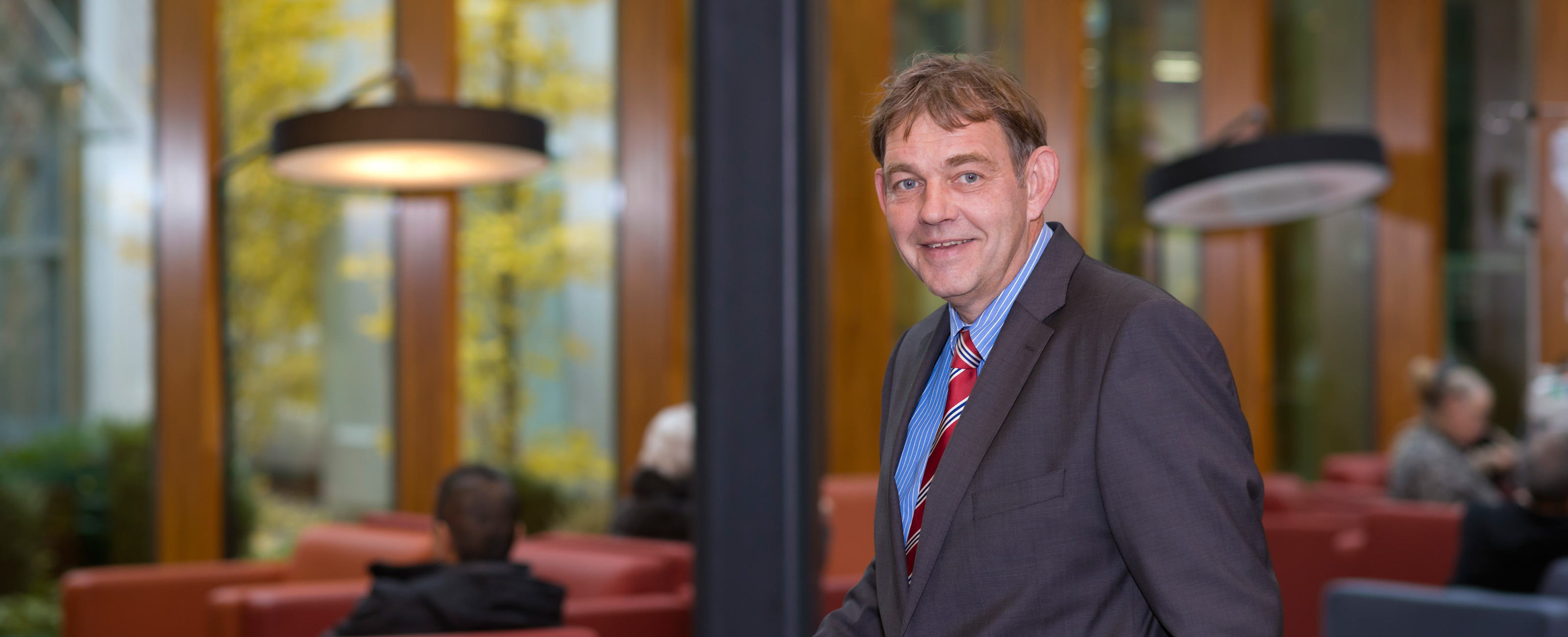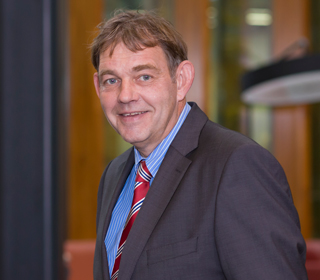Robbert Jan van der Ent Braat on RdGG
'Reinier de Graaf Hospital gives a new meaning to hospitality in healthcare'
That the building was finished within six years of the first initiative – hospitals usually take at least a decade – is also something that makes Robbert Jan van der Ent Braat proud.
But what matters most to him is to see happy faces when he walks through the Reinier de Graaf Hospital: people who enjoy working there and patients who avail of all the care they need in comfort. “It’s warm, welcoming, flexible, sustainable, functional, and it feels like a hotel. It turned out that way because it was designed and fitted out with EGM,” explains the Facility Manager on site in Delft. It’s about finding the right balance between a responsible design and incorporating all aspects of hospitality. “That calls for very close collaboration with the architect and mutual respect and trust. We succeeded very well in that endeavour with EGM!”
Starting in the middle of the crisis
“In 2009 the hospital management was on its knees. The plan to replace two outdated buildings, the former Bethel and Saint Hippolytus hospitals, with a new development turned out to be too expensive. Moreover, funds from the government had dried up, which meant that the organization had to arrange for its own funds through the banks. And the banking crisis was at its worst.”
That was when Robbert Jan took up his position as Facility Manager at Reinier de Graaf. There was a plan and an ambition, but in truth there was nothing. The chairman of the board at the time appointed Cees van der Zande to oversee the construction. His background in the care sector and my business experience proved a good combination. EGM also came on board in the figure of Eric Wendel. On the basis of new principles, a master plan and ultimately a new design were developed, enabling us – still deep in the financial crisis – to secure enough funding. Robbert Jan: “Collaborating means opening up to others, doing your work very professionally and deriving pleasure from what you do. The three of us – Eric, Cees and myself – danced together for three years. We were a wonderful trio and are immensely proud of the result. Unbelievable but true. In August 2015 we were able to open the doors of our new hospital.”
Collaborating means opening up to others, doing your work very professionally and deriving pleasure from what you do. The three of us – Eric, Cees and myself – danced together for three years
Anchored in Delft society
“Reinier de Graaf has a very low entry threshold: a wonderful central hall with plenty of daylight and direct access to the visitor restaurant with its open kitchen and table service. Staff and volunteers cordially point you in the right direction. The atmosphere is relaxed and warm. Yes, it does sound a bit like a hotel. That’s where my background reveals itself!”
“The hospital is for people from Delft and surrounding areas. That’s why we wanted to anchor the building and the interior to the surroundings and the history of Delft. Four themes were chosen right at the start of the process: the city, dunes, beach and glasshouses. Each theme has a wind direction: images of Delft adorn the walls facing the town, while the walls facing Westland depict glasshouses, and so on. The hospital features a colour palette based on the paintings of Johannes Vermeer. Every time a decision about the design or colour had to be made – for the floors, walls, curtains or furniture – we tested them according to the themes and colour palette.”
Hospitality means exceeding expectations
“More than 2500 people work in our hospital: doctors, nurses, volunteers and technical staff. They were intensively involved in the design process, enabling us to organize the working processes efficiently and innovatively. Examples include flexible offices for healthcare providers, flexible consultation and examination spaces, waste processing with the Pharmafilter system, and catering facilities and concepts for staff, visitors and patients. They certainly influenced the logistics of the building.”
“For patients and visitors alike, the route already starts outdoors, with the walk over the boulevard from the car park to the main entrance. The hospital facade contains a lot of detail and relief, including references to Delft as a town famed for its ceramics. The forecourt is spaciously laid out as a garden with seats and greenery, with plenty of space for the kiss-and-ride zone, where cars are guests. People then enter a hall with a playful tile motif, with floor tiles that refer to the pattern on Delft blue tiles.”
When it comes to hospitality, on a scale of 1 to 10, I aim to score 11. I recognized the same ambition in the work of EGM.
“With this building we are able to give the staff and patients much more choice in how they arrange their stay or work at the hospital. No inflexible work stations, no standard meals, to name just a few. If patients want to take visitors to the restaurant for food, they are welcome. They then get a voucher for a meal there instead of in their room. A wonderful restaurant with an open kitchen ‘in the heart of Delft’, with a menu consisting of dishes prepared with local products, they can for a moment forget they are patients and simply enjoy themselves. We ensure that everything looks right and all the pieces fit. Down to the details. Then everybody is happy!”
When it comes to hospitality, on a scale of 1 to 10, Robbert Jan aims to score 11. He recognized the same ambition in the work of EGM. "I immediately had a connection with architect Eric Wendel: he understood what I wanted, and throughout the design he offered ample freedom for the hospitality that I had in mind."
Caroline Kruit, journalist and publisher, interviewed Robbert Jan in December 2018
Project: Reinier de Graaf Gasthuis

